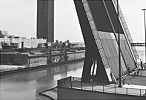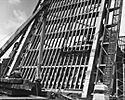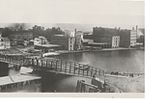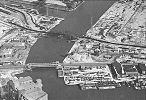Rivers have been a vital part of the Chicago region’s economic success. They have also been a potent barrier to urban development. The main branch of the Chicago River and its two branches divided Chicago from its earliest years into three parts: north division, west division, and south division. The conflict between the river as a harbor and the river as a barrier to intracity transportation played out over and over again over the course of Chicago’s history. The same conflict emerged when harbor traffic moved south to the Calumet River and region. Across the nineteenth and into the twentieth centuries, river traffic took precedence over land travel. Because sailing and steam ships needed clear access on waterways at the same places that people and vehicles needed to cross them, bridges had to be movable. Chicago engineers met these challenges in innovative ways.
Photo Essay Sections:
|
|
|
|
|
|
The Encyclopedia of Chicago © 2004 The Newberry Library. All Rights Reserved. Portions are copyrighted by other institutions and individuals. Additional information on copyright and permissions.



